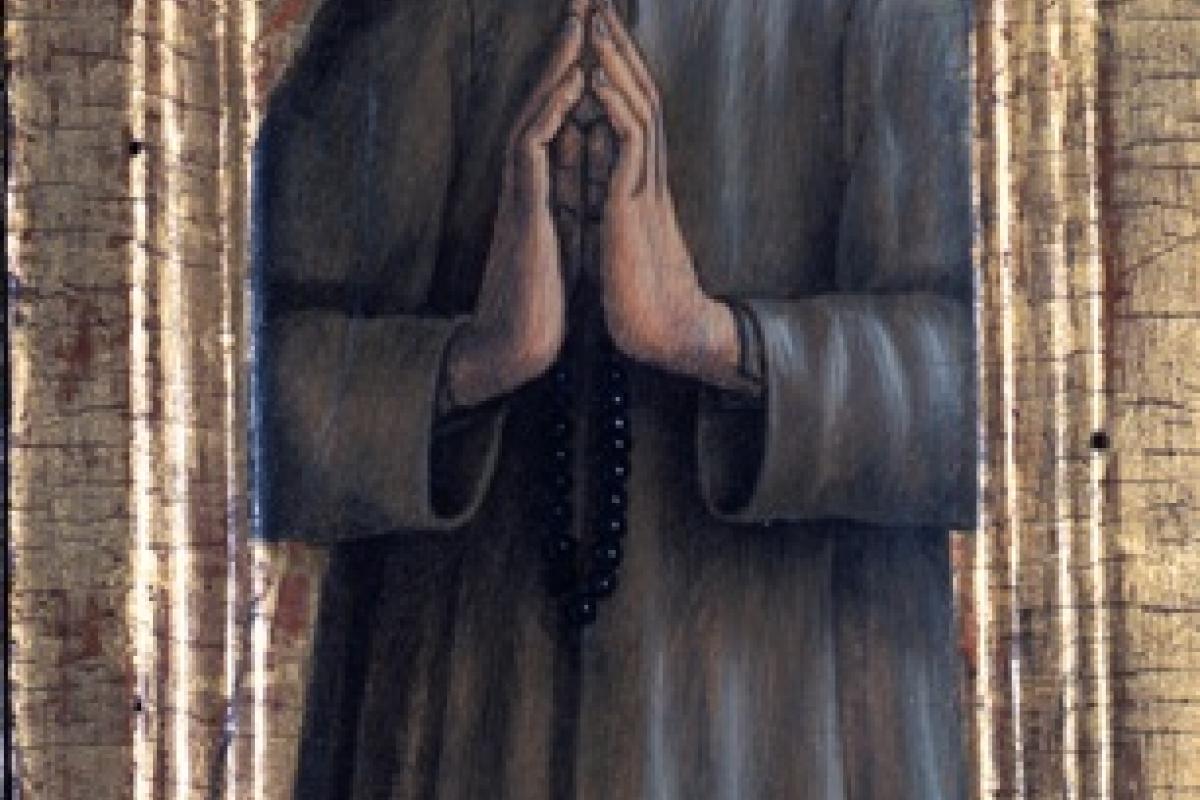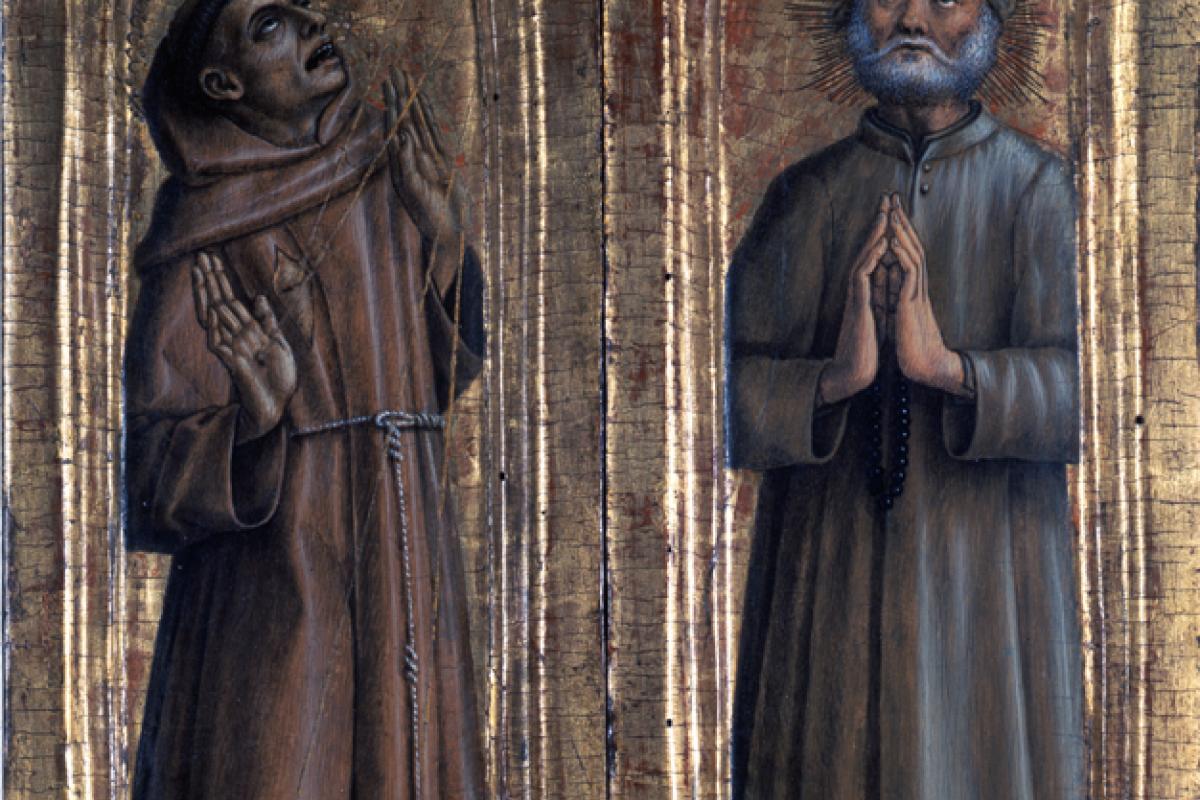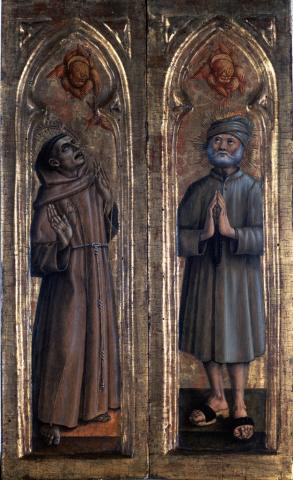The Blessed Andrea Gallerani
Crivelli, Carlo (Italian painter, born ca. 1430-1435, died before 1495)
The Blessed Andrea Gallerani
Italian, 1490
High Renaissance
tempera on wood
height 48.3 cm
width 14.6 cm
Portland Art Museum, 61.30
Gift of the Samuel H. Kress Foundation
Celia Latz, Medieval Portland Capstone Student, 2008
This small, inconspicuous panel titled The Blessed Andrea Gallerani is in nearly perfect condition. In spite of its size, it represents an artist of great importance within the European collection of the Portland Art Museum. Carlo Crivelli, born in Venice in 1430, painted it towards the end of his career in 1490 as part of a large altarpiece for the Duomo in Camerino. After extensive damage to the Duomo caused by an earthquake in 1778, the altarpiece was moved to the Brera Gallery in Milan where the main panel, The Madonna of the Candle, still resides. A similar panel that was part of this altarpiece, St Francis Receiving the Stigmata, together with The Blessed Andrea Gallerani, were later found in Rome and acquired by Samuel Kress in 1930 who donated both to the Portland Art Museum
These two figures were part of a group of twelve panels: all of similar composition and size, each with a gothic arch over a single saint or blessed holy-man. Six of the figures look to the right, and six to the left, all facing the central Madonna panel. St. Francis looks to the right while the Blessed Andrea Gallerani is turned to the left, indicating they were on opposite sides of the Madonna. In the Portland Art Association Catalogue of 1930, the panels are pictured detached from one another but were later connected in one frame, perhaps after the restoration of the panels in 1958.
There have been varying opinions regarding the identity of the figure that is presently labeled as Andrea Gallerani. Saint Francis has a halo while a gold aura emanates around Gallerani's head. At the time of the panel's purchase, it was listed in the Portland Art Association Catalogue as Saint Nicodemus. This was later disclaimed, for the aura, as opposed to a halo, distinguishes a holy man in the ranks of the blessed from a saint. For lack of better evidence, this figure was identified as Andrea Gallerani, a devout layman whose cult is limited to Siena.
Recent research by Ronald Lightbown indicates the true identity of the figures the Blessed Ugolino. A predella panel painted by Carlo Crivelli in 1482 for the altarpiece in the San Domenico cathedral of Camerino depicts the Beato Ugolino, who bears a remarkable resemblance to the 'Gallerani' portrait of 1490. Ugolino is wearing the same turban and tunic, the same beard, with hands united in prayer in a pose identical to the later depiction of Gallerani. There are several differences between the first image of Gallerani and the latter. The first portrait of Ugolino is painted from the waist up. He is holding a rosary made of pearls with a jeweled cross, has an unexplained halo, and his eyes gaze downward. Crivelli seems to correct his latter depiction of Ugolino by substituting the halo with an aura, and the pearl and jeweled cross with a simple string of black beads, more suitable for a hermit. The eyes gaze devoutly toward heaven and the figure is complete, displaying bare legs beneath the knee-length tunic with wooden and leather clogs on his feet. Such clogs were given to Ugolino by the peasants during his hermitage in the hills surrounding Camerino.
It is more plausible that a popular local figure would have been commissioned for the altarpiece instead of Andrea Gallerani whose fame was limited to Siena. Most of the friars of the Duomo in Camerino were of the area and they had strong loyalty to local holy men. Ugolino lived for thirty years in the mountains surrounding Camerino and was famous for his ascetic existence and for healing the sick who sought him out. He died in 1373, a little over 100 years before the Crivelli portrait was commissioned for the San Domenico church in Camerino. Today there is a sanctuary in honor of the Blessed Ugolino in the community of Montana of Camerino.
In light of Lightbown's convincing argument, the panel may indeed be of the Blessed Ugolino unless Crivelli had the liberty to choose his subjects and included Andrea Gallerani for a personal reason. Andrea Gallerani was convicted of murder and served time in prison resulting in his devoutness to compensate for his sin. Crivelli was convicted of adultery when he was about 25 and spent two years in prison. This changed the course of his life. Before his conviction, there is no evidence that he painted, but after his prison sentence, he religiously dedicated his life to painting. When liberated from prison, Crivelli left Venice and spent time in Padova studying with Squarcione, Mantegna, and Schiavone. He then went to Zara with Schiavone, who was from Dalmatia and became a Dalmatian citizen, eventually settling in the Marches and dedicating his life to art with a diligence bordering on fanaticism. Thanks to his extreme attention to method and technique in the preparation of egg tempera which he used exclusively, and to the proper preparation of wood panels, his paintings have remained in excellent condition.
Crivelli's self-imposed exile and travels influenced his work resulting in a style of painting unlike the Venetian style of the time. He moved to the Marches in 1468 - far from the cultural centers. His commissions were mainly from provincial churches and priests who were out of contact with the humanistic trends of the time. Although he was a contemporary of Bellini and Titian, his style is altogether different, resembling Gothic painting rather than Renaissance. He adhered to the outdated use of flat gold-leafed backgrounds, and his figures seem to be inspired by Greek icons. He was capable of painting perspective but rarely used it. Instead, obsessive attention was given to veins and tendons, while he ignored correct anatomical proportions preferring to emphasize hands and facial expressions to characterize his subjects. In the 'Gallerani' panel, the hands are disproportionately large to emphasize the importance of devout prayer associated with this figure. His feet are gnarly and swollen giving the impression of exposure and rugged wear and tear - congruous to a hermitic life in the mountains. Keen attention was paid to each stitch and fold in elaborately woven cloth and garments making even St. John the Baptist's hair tunic look like an expensive fur created by a high-end fashion designer. || Although Crivelli's technique recalled the Gothic world, it also projected into the future, circumventing the naturalism of his contemporaries. His fantastic scenes and dramatic characters, who seem to be caricatures of themselves, anticipated modern entertainment in Technicolor. His richly chromatic, detailed scenery, his dramatic and confident dragon-slayers, his fetching, coy Mary Magdalen in lush costume, and the perfectly coiffed Saint Catherine delicately fingering her wheel of torture, all seem to belong to the world of cinema, ready to act out their stories on the big screen.
Who this panel truly represents is not as important as what it represents. Be it Nicodemus, Andrea Gallerani, or Ugolino, it is surely a Carlo Crivelli. He occupies little space in the Portland Art Museum, but he is of great importance as one of the most unconventional and unique painters of the quattrocento.
Bibliography and Suggested Reading on Carlo Crivelli:
Bovero, A., L'Opera Completa del Crivelli, (Milan 1974); Rizzoli Editore
Lightbown, R., Carlo Crivelli, (Italy 2004); Yale University Press, p. 297-98 predella panel from the alterpiece for San Domenico, Camerino, 1482; p. 421.
Polverari, M., Gli Abiti di Carlo Crivelli, (Ancona,1990); Assessorato ai Beni, comune di Ancona.
Portland Art Association Catalogues, 1930-1939, File 2 Portland Art Museum; p.42.
Shapley, Fern R., Paintings from the Samuel Kress Collection, (London, 1968)/ Phaidon Press, p.4.
Webb D., Saints and Cities in Medieval Italy, (Manchester and NewYork, 2007); Manchester University Press.
Zampetti, P., Carlo Crivelli, (Florence, 1986); Nardini Editore.
Zampetti, P., A Dictionary of Venetian Painters, (England, 1969); F Lewis Publishers Limited.
Zampetti, P., Crivelli e I Crivelleschi, (Venezia,1961); Edizione Alfieri.





